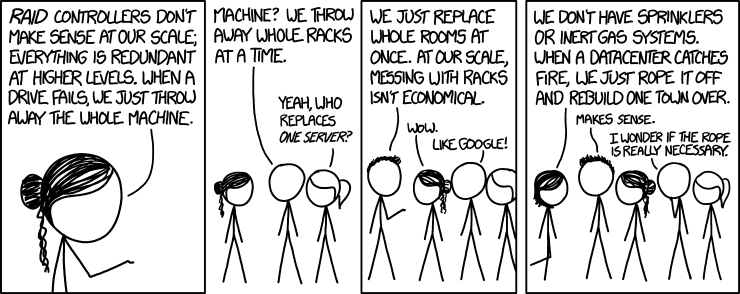1737: Datacenter Scale
| Datacenter Scale |
 Title text: Asimov's Cosmic AC was created by linking all datacenters through hyperspace, which explains a lot. It didn't reverse entropy--it just discarded the universe when it reached end-of-life and ordered a new one. |
Explanation
| This is one of 57 incomplete explanations: Created by a BOT - Please change this comment when editing this page. If you can fix this issue, edit the page! |
Transcript
| This is one of 30 incomplete transcripts. Please help by editing it! |
Discussion
While the comic is obviously exaggerating, there are situations where this could make a certain amount of sense. IF you can design a server so that most or all of the components reach end-of-life at about the same time, then if a hard drive fails on one server, every other component of that server is likely to fail soon as well.
If you install entire server racks or server rooms at the same time, where every machine contains components with the same basic life cycle...
then in theory, once the first component fails, you can ignore it until mass component failures causes the entire rack/room to fall below a certain readiness level.
At that point, there's no reason to pay a technician to spend several days removing and replacing half the individual components throughout that rack/room, when the other half are just going to fail in the next few months anyway. In theory, it might be economically more efficient just to scrap everything at once, bring in brand-new server replacements, and re-sync the needed data from a networked backup.
in real life, it's very hard to build a server that will reliably degrade on schedule.... but with the right tradeoffs, and enough long-term performance data, it might eventually become possible to do so. 162.158.74.101 04:48, 23 September 2016 (UTC)
- Or give the equipment to someone with a different time/ROI equation. I've seen a lot of time/expense burned on a transient failure that turned out to be a cheap data cable. A kid/disadvantaged would have time to tinker this out with a potentially significant payoff. Elvenivle (talk) 17:27, 23 September 2016 (UTC)
The title text is referring to The Last Question by Isaac Asimov. EpicWolverine (talk) 04:56, 23 September 2016 (UTC)
I cannot help but read this in a fake Yorkshire accent. https://en.wikipedia.org/wiki/Four_Yorkshiremen_sketch 141.101.98.113 09:55, 23 September 2016 (UTC)
I wonder how closely the AC and Douglas Adams' Deep Thought are related? 188.114.102.167 (talk) (please sign your comments with ~~~~)
- Not that close as Deep Thought was build inside this universe and also finished it's job and was recommissioned. They build a new computer (Earth) instead to calculate what the ultimate question was, now they knew the answer was 42. But maybe Adams was aware of AC and based the idea of solving a question with computers on that...? --Kynde (talk) 13:56, 23 September 2016 (UTC)
I think the character in Panel 1 is Science Girl and not Hairbun. PoconoChuck (talk) 12:20, 23 September 2016 (UTC)
- Agree it fits with her style and she has appeared as an adult before. She also seems smaller than the other people so it could indicate she is still young. I created the Science Girl and the Hairbun categories, so I should know ;-) When a character fail I just throw it out and create a new one... :p --Kynde (talk) 13:52, 23 September 2016 (UTC)
- It's clearly not Science Girl, because, as the linked page says "She became the first child to have its own character category. She is distinguished by being clearly a girl (compared to adults around her or her behavior)". You may create a page called "Datacenter Woman". 108.162.221.139 14:35, 23 September 2016 (UTC)
- I dunno - she's drawn exactly like Science Girl - right down to the frizzy hair below the bun that's never been seen on Hairbun (who doesn't have black hair either). There are plenty of other instances of "child" characters being seen as young adults - and of people acting out of character when "bit parts" are needed in cartoons. The resemblance is too close to be a coincidence. SteveBaker (talk) 20:41, 23 September 2016 (UTC)
- No need to invoke blade servers
There's no need to refer to blade servers in the explanation. You can fit many "normal" servers into a 19 inch rack. It could just say:
- From here, the comic starts to exaggerate. Many servers can be mounted in one 19-inch rack in a data center. Rather than going to the effort of unplugging and unscrewing one server from the rack, when a disk fails at Cueball's data center they just throw away the rack, and Ponytail agrees and kinda mock the woman with a bun for replacing a single server.
162.158.83.66 14:51, 23 September 2016 (UTC)
- RAID is not complicated
Simple RAID 1 is not complicated to configure, unless you have some exotic HW RAID controllers. RAID 5 would be more complicated AND requires to be HW, but RAID 1 will usually be simple as HW OR possible to do SW completely automatically. What is costly is to replace discs as they fail, because it must be done by human ; in bigger systems, it makes more sense to start with RAID 1, then when one disc fail simply ignore it - not repair nor throw it off, just let it operate without the RAID. -- Hkmaly (talk) 15:41, 23 September 2016 (UTC)
- Actually, depending on OS and software other RAID levels can be done in software, too. I've done RAID levels 5 and 6 fully in software using mdraid on Linux. Neither of them are really that much more complicated than RAID-1. ZFS can do even more complicated "RAID" types fully in software, too. Iguanabob (talk) 16:55, 23 September 2016 (UTC)
- Gas-based data center fire extinguishers are not lethal
